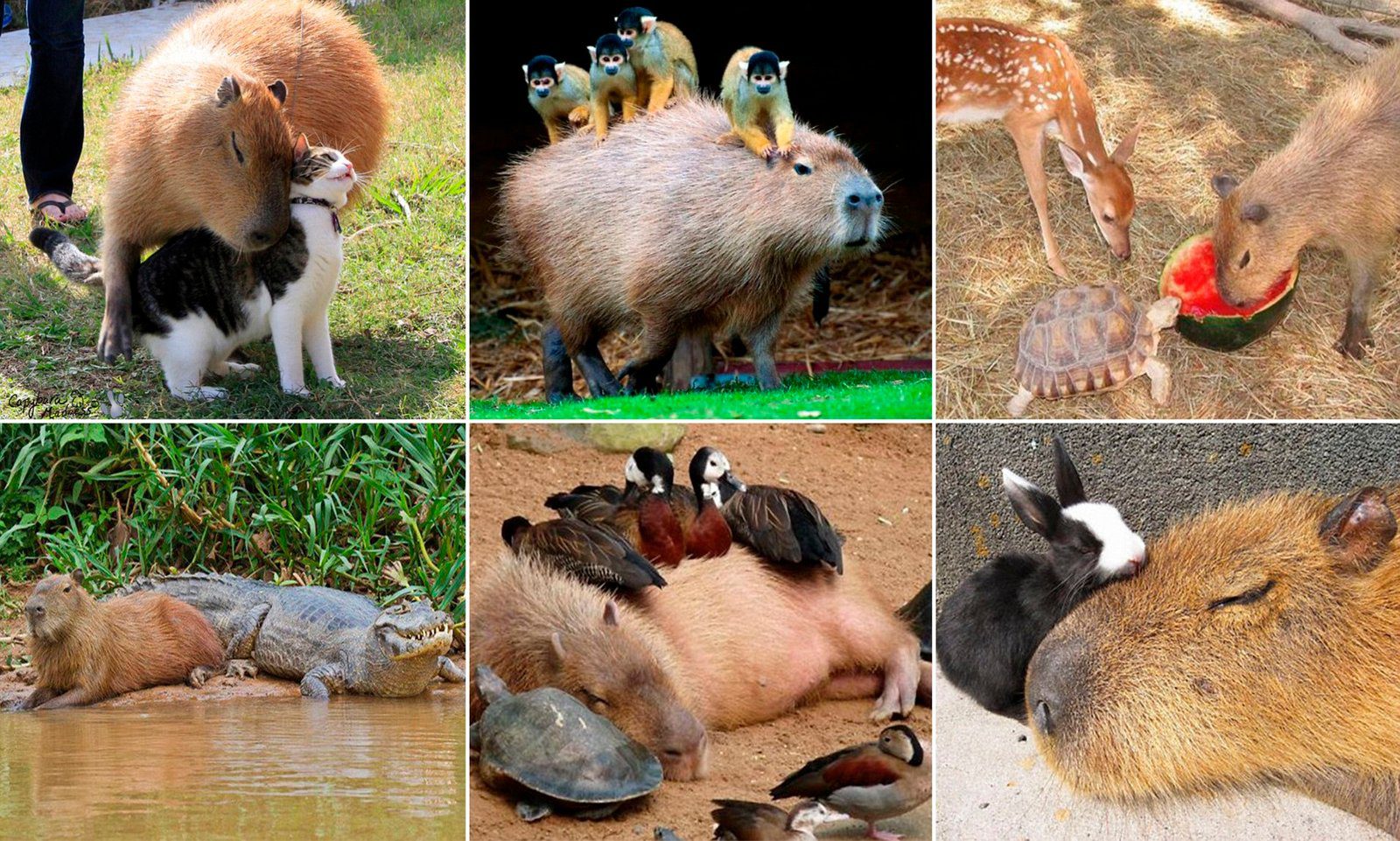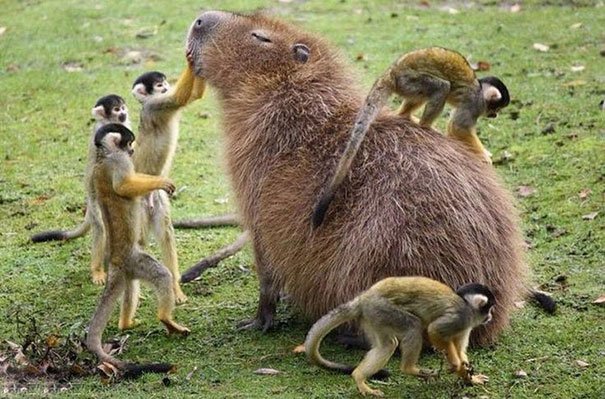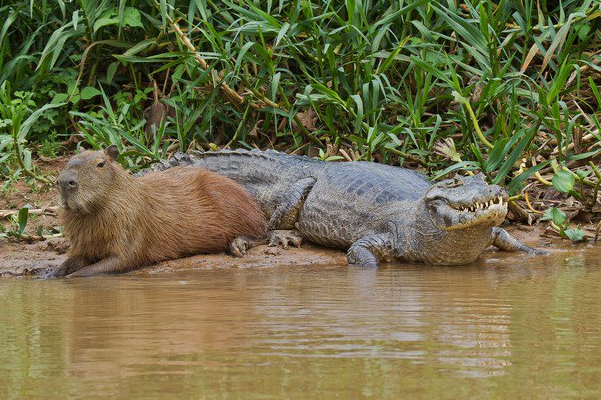Table of Contents
Have you ever wondered how capybaras, those adorable and social creatures, interact with other animals? It turns out that capybaras are extremely friendly and have a unique ability to create harmonious relationships with various species. From their calm demeanor to their inclusive nature, capybaras have a remarkable talent for fostering camaraderie among their fellow animal companions. In this article, we will explore the fascinating dynamics of how capybaras get along with other animals, unveiling the secrets behind their remarkable social skills. So, get ready to dive into the captivating world of capybara friendships!

Adaptability of Capybaras
Capybaras, the largest rodents in the world, are known for their remarkable adaptability. They have the unique ability to thrive in various ecosystems, making them highly versatile animals. Whether it’s the dense Amazon rainforest, the grassy savannahs, or even urban areas, capybaras have shown their resilience and ability to adapt to different environments.
Capybaras as Social Animals
One of the key factors contributing to the adaptability of capybaras is their highly social nature. These gentle creatures are extremely sociable and are usually found living in large groups, commonly known as herds. Their strong social bonds enable them to successfully navigate different ecosystems by relying on the cooperative efforts of the group.
Capybaras have a hierarchical social structure within their herds, with a dominant male leading the group. The hierarchy helps maintain order and allows them to make collective decisions for the benefit of the entire herd. This social cohesion plays a significant role in their adaptability as they depend on each other for tasks like finding food, caring for the young, and even protecting themselves from predators.
Ability to Live in Different Ecosystems
Capybaras have shown an incredible ability to inhabit various ecosystems, making them adaptable to a wide range of environments. In their natural habitat, they are found near bodies of water such as rivers, lakes, and marshes. This is because capybaras are excellent swimmers and utilize water as a means of escaping predators and regulating their body temperature.
Their semi-aquatic lifestyle allows them to coexist with different species that inhabit water ecosystems, including fish, amphibians, and reptiles. Capybaras are known to share the same habitat with caimans, turtles, and even certain bird species like herons and kingfishers.
In addition to their water-based habitats, capybaras have also shown adaptability to different types of terrestrial environments. They are found in grasslands, wetlands, and even tropical forests. This versatility makes them capable of living alongside a wide variety of animals, creating unique ecological dynamics in each ecosystem they inhabit.
Interactions with Canines
Positive Relationships with Dogs
Capybaras have an astonishing ability to form positive relationships with dogs. This compatibility between two seemingly different animals has fascinated researchers and animal lovers alike. Due to their social nature, capybaras readily accept other animals into their social circle, including dogs.
Dog and capybara interactions have been observed in various settings, including zoos, parks, and even in domestic environments. In some cases, these relationships have proven to be deeply affectionate, with capybaras and dogs engaging in mutual grooming and cuddling. This is often attributed to the calm and friendly demeanor exhibited by both species.
Cautions to Consider when Introducing Capybaras to Dogs
While capybaras and dogs can have harmonious relationships, certain cautions should be taken when introducing these animals. Firstly, it is essential to ensure that the dog is well-behaved, obedient, and has been socialized properly. Aggressive, unpredictable, or overly energetic dogs may pose a risk to the capybara’s well-being.
Another consideration is the size and strength difference between capybaras and dogs. Capybaras can grow to be quite large and may unintentionally cause harm to smaller dogs during play or even regular interactions. It is crucial to closely supervise their interactions to ensure the safety of both animals.
Additionally, it’s important to provide sufficient space and resources for both the capybara and dog to avoid potential territorial conflicts. Adequate food, water, and shelter should be provided for each animal to minimize the likelihood of aggression.

Compatibility with Equines
Calm Relationship with Horses
Capybaras have also been observed to have a calm relationship with horses. Similar to their interactions with dogs, capybaras can form bonds with horses and even share grazing areas without major issues. This compatibility is thought to be primarily due to the peaceful nature of both species.
The gentle and non-threatening demeanor of capybaras seems to have a soothing effect on horses, helping to create a peaceful coexistence. In some cases, capybaras have been observed engaging in mutual grooming with horses, further solidifying their bond.
Considerations for Keeping Capybaras and Horses Together
While capybaras and horses can form harmonious relationships, several considerations need to be taken into account when keeping them together. Firstly, it’s important to ensure that the horse is introduced to the capybara gradually, allowing them to become acquainted in a controlled and supervised environment.
It’s crucial to monitor their interactions closely, especially during the initial stages, to prevent any potential misunderstandings or aggressive behaviors. Horses may be larger and more powerful than capybaras, so caution should be exercised to avoid any accidental harm to either animal.
Additionally, providing ample grazing areas and resources such as food and water is essential to prevent competition and potential conflicts. Proper shelter and resting areas should also be provided to ensure the well-being of both animals.
Capybaras and Birds
Coexistence with Avian Species
Capybaras are typically peaceful and tolerant towards avian species, allowing for coexistence in various ecosystems. In their natural habitats, capybaras can often be seen sharing the same habitat with a wide range of birds, including waterfowl, wading birds, and even certain predatory birds.
Capybaras’ close association with water makes them particularly attractive to water-dwelling bird species. They provide a safe resting place for birds and can even help create nesting platforms for them through their presence and activities in the water.
Potential Risks for Birds and Capybaras
While capybaras generally pose no threat to birds, there are potential risks that need to be considered. Large predatory birds, such as eagles and hawks, may occasionally target capybara young and small bird species for food. These interactions are relatively rare but should be acknowledged to have a comprehensive understanding of the capybara’s relationship with birds.
Furthermore, birds that nest near capybara habitats should ensure that their nests are secure from any potential disturbances caused by capybaras. Capybaras may inadvertently destroy nests or trample on eggs during their activities, so nesting birds should take precautions to minimize these risks.
Interaction with Farm Animals
Capybaras and Cattle
Capybaras generally have peaceful interactions with cattle, and they can often be found sharing grazing areas. This peaceful coexistence is primarily due to the capybara’s non-threatening nature and the calm temperament of cattle.
Capybaras may even benefit cattle by acting as natural pest controllers. They can consume large amounts of grass and aquatic plants, helping to control vegetation growth in their shared environments.
Capybaras and Goats
Capybaras and goats can also coexist peacefully in certain settings. As herbivores, both capybaras and goats have a similar diet, reducing the chances of competition for food resources. They can often be seen grazing alongside each other without any major conflicts.
However, it’s important to note that capybaras are significantly larger than goats and may unintentionally cause harm if they become overly playful or if conflicts arise. Therefore, close supervision is necessary, especially if capybaras and goats are kept together in confined spaces.
Capybaras and Pigs
Capybaras and pigs generally have a peaceful relationship and can often be found sharing habitats, particularly in wetland areas. Both species are known to appreciate water and wallow in muddy areas for various reasons, such as temperature regulation or to deter parasites.
However, it’s worth noting that pigs can be more aggressive than capybaras, especially if there is competition for resources. It is essential to provide enough space, food, and water to minimize the likelihood of conflict. Regular monitoring and observation should also be conducted to ensure the well-being of both animals.
Coexistence with Small Animals
Harmonious Relationships with Rabbits and Guinea Pigs
Capybaras tend to have harmonious relationships with small animals such as rabbits and guinea pigs. Due to their peaceful nature, capybaras usually display tolerance and acceptance towards these smaller companions.
In some cases, capybaras and rabbits have been observed grazing together or engaging in mutual grooming. This compatibility between capybaras and small mammals demonstrates the adaptable and friendly nature of capybaras.
Supervision Required with Small Rodents
While capybaras generally get along well with small animals like rabbits and guinea pigs, caution should be exercised when introducing them to smaller rodents such as hamsters or mice. Capybaras may mistake smaller rodents as prey, leading to potentially harmful interactions.
Therefore, close supervision is necessary to ensure the safety and well-being of all animals involved. It’s important to create safe and separate spaces for capybaras and smaller rodents if they are to coexist in proximity.

Capybaras and Reptiles
Minimal Interaction with Reptiles
Capybaras have minimal direct interaction with reptiles due to differences in their habitats and behaviors. While capybaras are often found in water ecosystems, reptiles such as snakes and lizards predominantly inhabit terrestrial or semi-aquatic environments.
Capybaras and reptiles are generally able to coexist without any major conflicts or interactions, as they occupy different niches within their ecosystems. Capybaras’ larger size and social structure also contribute to their ability to avoid or deter potential reptilian threats.
Isolated Cases of Harmful Encounters
Although rare, there have been isolated cases where capybaras and reptiles, particularly snakes, have had harmful encounters. Larger snakes, such as anacondas, have been known to prey on capybaras, especially the young and weaker individuals.
While these interactions are infrequent, it’s important to acknowledge the potential risks that exist when capybaras and reptiles share the same ecosystem. However, overall, capybaras’ adaptability and social nature allow them to navigate their environments successfully, minimizing the likelihood of harmful encounters.
Capybaras and Primates
Potential Compatibility with Certain Primate Species
Capybaras show potential compatibility with certain primate species, particularly those that exhibit a peaceful and non-aggressive nature. In some captive settings, capybaras have been observed cohabiting with certain primate species without major issues.
The social dynamics of capybaras may provide a sense of security for primates, as capybaras often form tight-knit groups and display cooperative behaviors. This can create a sense of stability and companionship for primates, contributing to their overall well-being.
Introducing Capybaras to Primates with Caution
While capybaras and primates may have the potential for compatibility, it is crucial to approach their introductions with caution and careful consideration. Each individual case may vary based on the specific species involved and the dynamics of the given environment.
Proper introductions and close monitoring should be conducted to assess the compatibility between capybaras and primates. Observing their interactions and ensuring the well-being and safety of all animals involved should be the top priority to establish a successful coexistence.

Wild Capybaras and Predators
Handling Relations with Predators in the Wild
In the wild, capybaras have to navigate their ecosystems while facing potential predators. Capybaras have developed various strategies to evade or deter predators, relying on their social structure, vocalizations, and their ability to rapidly seek refuge in water.
Capybaras’ herding behavior helps to provide safety in numbers, and their keen senses of hearing and smell enable them to detect potential threats from a distance. They also communicate with their herd members through a combination of vocalizations, including whistles and clicks, to alert each other about potential danger.
Predator Interactions Encountered by Capybaras
Capybaras encounter a range of predators in their natural habitats. The most common predators include large cats such as jaguars, pumas, and ocelots, as well as large birds of prey like caimans and anacondas. Young capybaras are particularly vulnerable to predation due to their small size and limited ability to defend themselves.
However, capybaras’ adaptability and social nature have enabled them to thrive despite these predator interactions. Through their collective efforts and vigilance, they have managed to overcome the challenges posed by their natural predators, establishing themselves as a peaceful and resilient species.
Capybaras as Peaceful Species
General Disposition Towards Other Animals
Capybaras, with their peaceful and sociable nature, are generally accepting and tolerant towards other animals. Their adaptability and cooperative behaviors have allowed them to live alongside a diverse array of species, exhibiting harmonious relationships in many cases.
Their ability to coexist with various animals is a testament to their flexible nature and their willingness to form bonds with different species. From socializing with dogs and horses to grazing near cattle and sharing habitats with birds, capybaras showcase their inclination towards peaceful coexistence.
Exceptions to Peaceful Nature
While capybaras are known for their tranquility, it’s essential to recognize that individual variations and specific circumstances may lead to exceptions in their peaceful nature. Factors such as aggression, territoriality, or fear can occasionally result in conflicts or harmful encounters.
Therefore, it is vital to assess each situation individually and monitor the interactions closely when introducing capybaras to other animals. Safety measures, proper introductions, and ongoing observation are crucial to ensure the well-being and compatibility of all animals involved.
In conclusion, capybaras’ adaptability and peaceful nature have allowed them to establish harmonious relationships with various animals across different ecosystems. Whether it’s their ability to interact positively with dogs, coexist with equines, or form bonds with other animals, capybaras have showcased their remarkable adaptability and friendly nature. While caution and supervision are necessary when introducing capybaras to other animals, their ability to live alongside different species highlights their unique place in the animal kingdom as peaceful and charismatic creatures.


